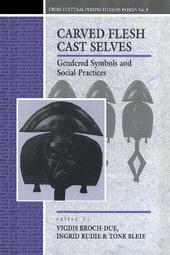
|
Carved Flesh / Cast Selves: Gendered Symbols and Social Practices
Paperback / softback
Main Details
| Title |
Carved Flesh / Cast Selves: Gendered Symbols and Social Practices
|
| Authors and Contributors |
Edited by Tone Bleie
|
|
Edited by Vigdis Broch-Due
|
|
Edited by I. Rudie
|
| Series | Cross-Cultural Perspectives on Women |
|---|
| Physical Properties |
| Format:Paperback / softback | | Pages:312 | | Dimensions(mm): Height 216,Width 138 |
|
| ISBN/Barcode |
9780854968688
|
| Classifications | Dewey:305.3 |
|---|
| Audience | |
|---|
|
Publishing Details |
| Publisher |
Bloomsbury Publishing PLC
|
| Imprint |
Berg Publishers
|
| Publication Date |
6 January 1993 |
| Publication Country |
United Kingdom
|
Description
This volume, the first comprehensive overview of Scandinavian cross-cultural research on gender issues in the English language, addresses fundamental analytical issues currently debated within international feminist anthropology and beyond. Offering examples from a wide range of ethnographic settings, the essays show that gender comprises far more than sexual relationships: it takes on political significance insofar as it influences the distribution of resources and access to public and domestic spheres, to knowledge and to power.
Author Biography
Vigdis Broch-Due I. Rudie Department of Social Anthropology,University of Oslo Tone Bleie Chair, Michelsen's Institute, Bergen
Reviews"... advances the theoretical discourse on the anthropology of the body ... is also intriguing because it introduces the reader to the "hotbed" of Norwegian thought on gender." Folk 'There is something for everyone here and reading the volume in sequence, rather than dipping into individual chapters, was an unusually pleasurable experience. The changing foci and styles produced its own rhythm, engaging the attention and maintaining the reader's interest as a complex theoretical argument would be superseded by a more descriptive and evocative ethnographic account. [...] In allowing us access to contemporary Norwegian anthropology it is a most welcome contribution and in providing further studies of gender it should prove a useful resource for both teachers and students of sociology and anthropology.' Journal of Gender Studies
|